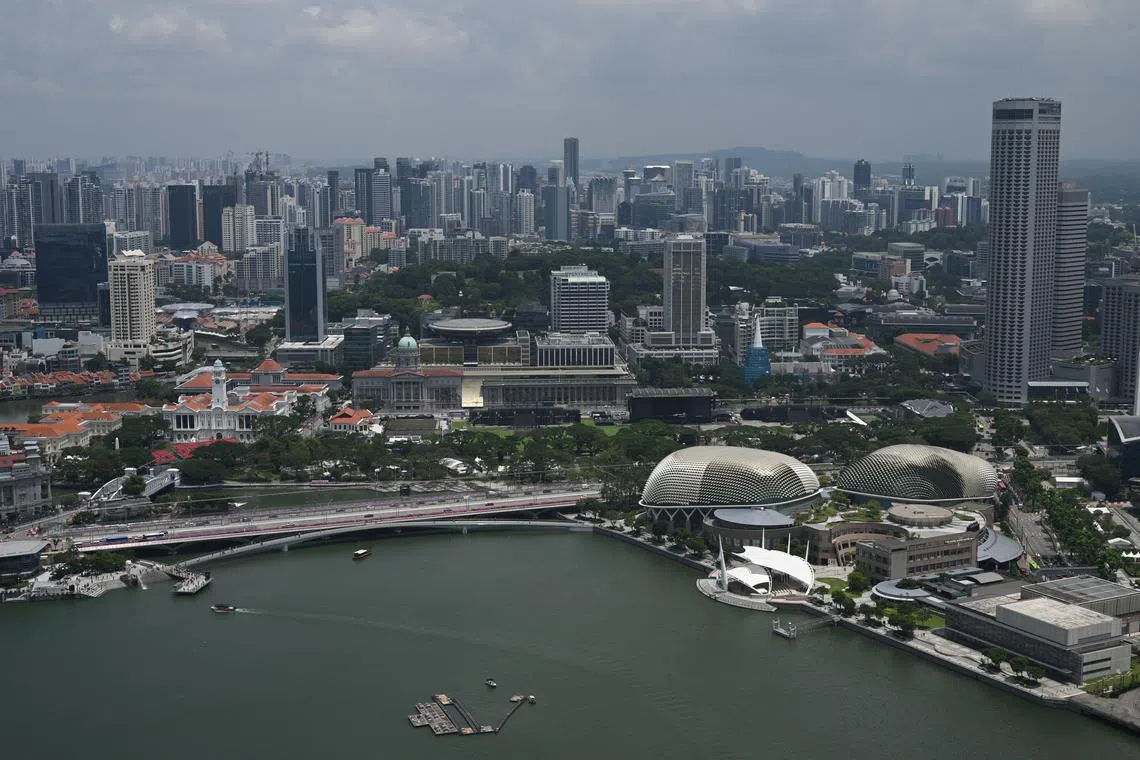IMF cuts S’pore 2023 growth forecast on weak exports, China slump; sees Asia slowing next year
Sign up now: Get ST's newsletters delivered to your inbox

Growth in Singapore will pick up to a pace of 2.1 per cent in 2024 but the outlook for Asia is for further moderation.
PHOTO: ST FILE
Follow topic:
SINGAPORE – Economic growth in Asia is likely to be 4.6 per cent in 2023, up from 3.9 per cent in 2022, despite a challenging global environment, said the International Monetary Fund (IMF) on Wednesday.
But the IMF lowered its 2023 growth projection for Singapore’s economy to 1 per cent from an earlier estimate of 1.5 per cent in April, as some Asian economies are hit harder by weaker global demand for goods exports and a slowing Chinese economy.
Singapore growth will pick up to a pace of 2.1 per cent in 2024, aided by the ongoing recovery in services and possibly a rebound in external demand for electronics, but the outlook for Asia is for further moderation, the IMF said in its Regional Economic Outlook update.
It said the growth momentum is slowing as global demand has rotated from goods to services while central banks worldwide have raised interest rates to fight inflation and, in the process, have tightened the supply of loans to businesses and households.
Meanwhile, China’s economy is losing steam after a brief pickup in the wake of its full reopening earlier in 2023
The world’s second-largest economy will grow by 5 per cent in 2023 before decelerating to 4.2 per cent in 2024 – down from 4.4 per cent predicted earlier – due to lacklustre investment and a slump in the property sector.
“The real estate sector in China is grappling with further pressures on debt repayments, home sales and investment,” Dr Krishna Srinivasan, director of IMF’s Asia-Pacific department, said in a news briefing after the launch of the report.
The IMF did upgrade the growth outlook for the US and Japan – both major buyers of Asian goods – but believes that it will not completely offset the drag from China.
In fact, the IMF believes that China is in a structural slowdown, which will bring down its medium-term growth spread over the next five years to just 3.8 per cent on average.
Dr Srinivasan said that geopolitical fragmentation – where some advanced countries like the US are friend-shoring or re-shoring manufacturing – will also hurt growth and productivity in China and some other Asian economies and bring the region’s medium-term growth down to 3.9 per cent.
“We highlighted in April that China’s growth is slowing down over time. This could affect the growth of other countries in Asia and the world because of China’s deep integration into global value chains,” he said.
The IMF also said risks to the near-term outlook, globally and in Asia, remain tilted to the downside, even as they are more balanced than six months ago.
“A weaker-than-expected recovery in China could trigger negative spillovers to its trading partners. Abrupt financial tightening in the United States or within the region would inhibit growth, especially in highly leveraged economies and sectors,” the IMF said in the report.
Things may take a positive turn only if the US economy achieves a soft landing – boosting the outlook for manufacturing and capital expenditures – the technology cycle bottoms out, and disinflation in Asia accelerates to provide scope for easing monetary policy in 2024.
However, medium-term prospects are uncertain due to geo-economic fragmentation, with de-risking policies of major economies creating a potentially significant impact on growth, it said.
While inflation is expected to ease in 2024, the IMF advised central banks to ensure that inflation remains durably at appropriate targets.
It said that in Asia’s advanced economies – which include Australia, New Zealand, Japan, Hong Kong, South Korea, Taiwan and Singapore – tight financial conditions as represented by high interest rates will hold back demand, while the outlook for exports will depend on price movements of global commodities and the technology cycle.
The IMF said that due to strong business investment and resilient consumption growth, US growth for 2023 and 2024 was upgraded in the October 2023 World Economic Outlook by 0.5 per cent and 0.4 per cent, respectively, compared with April.
“While the large upgrade to US growth compared to a smaller downgrade for China would normally be a net positive for the region, the composition of US demand may mean that Asia will benefit less this time.”
Also, the demand for electronic goods has moderated as an upturn of the technology cycle appears to be delayed, while de-risking policies by major economies are reorienting demand for goods towards domestic sources instead of imports, said the IMF.
Beyond the slowdown in China and geopolitical fragmentation, the IMF remains worried about structural trends that preceded the Covid-19 pandemic, such as an ageing population and slowing productivity that will continue to weigh on the growth outlook in the medium term.
Dr Thomas Helbling, deputy director of IMF’s Asia-Pacific department, said more recently that investment flows have also started to slow.
These are needed, especially by emerging economies, to access new technologies that boost productivity growth and upscale human capital, he said.


